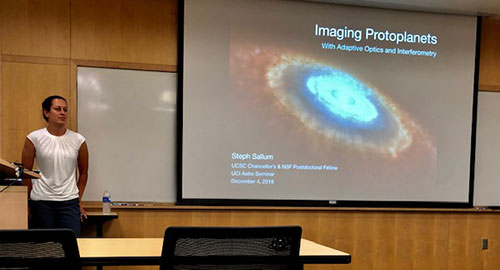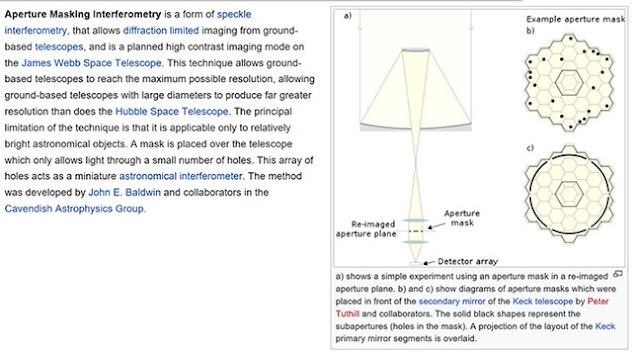Well, we finally found the lost copy of "The Art of Chesley Bonestell", which we have enjoyed re-reading, but for this week the blog concentrates on other astronomy topics.
Yes, the book was found tucked away in a bookshelf behind some astronomical equipment and now is readily available and we really enjoy looking at the art. In looking through the book, I found the original Amazon purchase receipt from 2014 and discovered that it was no other than Gravity Guy, Ken, who turned me on to the work of Bonestell. Thanks for that, Ken!
If you want to find me information or find out about the next screening of the documentary film, Chesley Bonestell: A Brush with the Future, then check out the film's website: http://www.chesleybonestell.com/
 |
| Finally put the copy of "The Art of Chesley Bonestell on the coffee table (Source: Palmia Observatory) |
Before getting into the main topics, we should mark two upcoming meetings on the calendar. First, is the upcoming 233th American Astronomical Society meeting in Seattle, WA on Jan 6-10, 2019. As a new amateur affiliate member I will be there and hope to see you all there as well!
Next, for all of you interested in learning more and doing more in astronomical spectroscopy, you should check out and this spectroscopy workshop to your calendars. The second Sacramento Mountains Spectroscopy workshop will be held in Las Cruces, New Mexico on February 22-24, 2019. The workshop will cover the underlying principles and practical aspects of what equipment can be used. Wow, I would really like to attend this workshop, but unfortunately we will be searching for the northern lights at that time. If you are interested in the workshop then check out their webpage at: http://www.smswweb.com/.
Ok, now its time to get back to UCI for an astrophysics seminar about imaging protoplanets by Dr. Steph Sallum, UCSC postdoc. Her presentation covered some of the details and findings about the development of planetary systems. The problem with trying to observe exoplanets is that hey are so far away and are so close to their star that it is difficult to resolve the planet's image. Now I had a harder time following the fast pace discussion of how measurements are made for all of the evolutionary stages of planet formation, from birth of the star itself from the collapse of a molecular cloud, which continues to form a disk which then can form planets.
 |
| Dr. Steph Sallum, UCSC Postdoc, getting ready to begin the seminar on Imaging Protoplanets |
But what I was most intrigued by was the technique used to increase the resolving power of telescopes so that the small fine details of the planetary disk can be observed. We are talking about milli-arcsecond resolution in the optical and IR wavelengths. We know that in radio wavelengths the very large arrays of telescopes can be operated as interferometers with very long baselines to achieve very high angular resolution, but the approach described by Dr. Sallum was of Non-redundant Masking (NRM), which is used in optical telescopes. Thanks for that, Dr. Sallum!
Astronomers including amateur astronomers use a somewhat similar technique, like speckle interferometry, to increase the optical resolution of telescope measurements to enable the separation of closely orbiting binary stars.
The concept of NRM, at first sounds completely counterintuitive. The approach is to block off most of the light coming into a large telescope and only let light through a few small apertures. Check out this approach, now proposed for the James Webb Space Telescope. So you go to all the trouble to build this large mirror and now for some types of observations, you only let light through to the camera in only a small number of locations. Then by comparing the light from separate pairs of these small apertures, the seeing and resolution can be increased and this technique allow ground based telescopes to have higher resolution than that of the HST. Pretty neat!
 |
Counterintuitive approach of non-redundant masking to improve resolution (Source: Wikipedia AMI) |
This approach only works for bright objects, but the resolution of the telescope is made much larger. The proposed filter wheel for the JWST is shown below. The mask has seven holes which let much less light though than that collected by the whole mirror system, but the increase possible in angular resolution is worth it for many bright objects.
 |
| Prototype mask for JWST (Source: www.jwst.docs.stci.edu) |
The theory of why this concept works is a bit complicated and I am only beginning to see how it works. One of the key points is that by allowing light through in only a small number of apertures, the effects of bad seeing or phase errors in the incoming light can be eliminated by some complicated signal processing on pairs signals from mask apertures. The NRM allows one to calculate and compensate for many of the factors that limit the diffraction limit of the telescope. When light from the full aperture is used the wave fronts from the target are all mashed up and summed together, but for the NRM case, the phase errors can be summed together between pairs of the individual mask points and the phase errors can be cancelled out. The introduction from one JWST documents shown below describes some of the complication. The performance improvement is quite dramatic
 |
| Summary of resolution improvement from AMI and NRM (Source: www.jwst.docs.stci.edu) |
So, I still don't quite understand all of it, but the results seem quite impressive. We will have to work through more of the details. Ok, my head hurts, so let's actually do some nighttime observing.
Finally, on the astronomical observing calendar, we received the monthly Sky Wire by OC Telescope, and it mentioned that Comet 46P/Wirtanen will make its closest approach to the sun on December 16 and should be naked eye visible at that time. Well, just to see what could be seen right now, it was time to pack up the DSLR and tripod and go outside an take a look! It was going to be tonight, or wait for a couple of days for the storm to move through.
To find where to point the DSLR, I used Sky Safari Pro to identify where 47P was located. At the time of observation, the comet was located at about 180 degrees south and just about 2 degrees lower in altitude than is the bright star in Orion, Bellatrix. So, pointing the camera in the right direction was pretty straightforward. Any bright enough star to be seen in city lights would have worked, but Bellatrix was the closest one to where the comet was supposed to be.
The 150mm, 8 second, image below, taken in city lights on a non-tracking tripod shows just a dim blue glow. Longer exposures resulted in more streaking and the ISO was already set quite high at 3200.
 | |
|
 | |
|
Anyway, we know the story about how clouds are always getting in the way. But, one piece of good news about clouds is that sometimes they come with rainbows. It turned out in the morning after the comet image was made, a beautiful double rainbow image showed up. I saw a strange morning glow outside the windows and went out with just my PJ's and iPhone and experienced this wonderful rainbow!
 |
| Even if clouds will block the evening star gazing, this (6:56 PST) morning rainbow is worth it (Source: Palmia Observatory) |
Until next time,
Resident Astronomer George
If you are interested in things astronomical or in astrophysics and cosmology
Check out other postings on this blog at www.palmiaobservatory.com

No comments:
Post a Comment